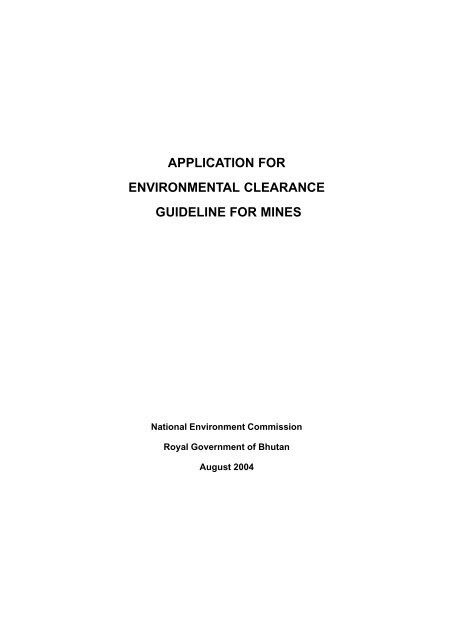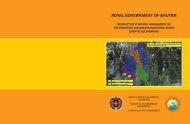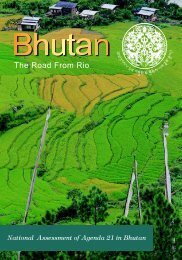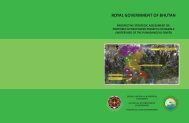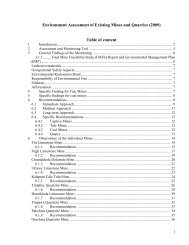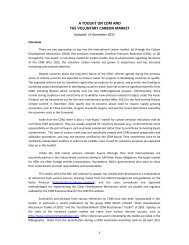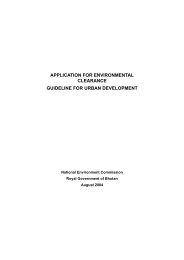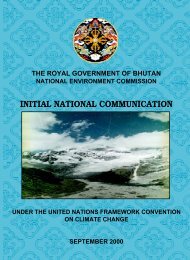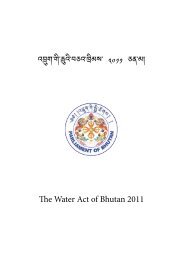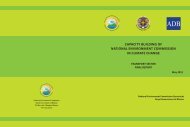application for environmental clearance guideline for mines
application for environmental clearance guideline for mines
application for environmental clearance guideline for mines
Create successful ePaper yourself
Turn your PDF publications into a flip-book with our unique Google optimized e-Paper software.
while the demand <strong>for</strong> rural access to market facilities in the <strong>for</strong>m of farm roadsand feeder roads is increasing with every Five Year Plan - in the 9th Five YearPlan alone there is a plan to develop 588kms of farm roads. Environmentalissues such as waste disposal related to urbanization are also becoming seriousconcerns <strong>for</strong> Bhutan. Bhutan is lauded by the international community <strong>for</strong> itssound <strong>environmental</strong> policies and the political will to implement these policies.However, <strong>environmental</strong> problems are becoming more and more visible andinstruments like the EA Act 2000 must be implemented effectively to support thegovernment’s sound <strong>environmental</strong> policies and to ensure that Bhutan remainsclean and green.The <strong>environmental</strong> assessment process endeavors to mitigate and prevent theundesirable impacts of developmental activities. It is in no way intended to hampersocio-economic development in Bhutan but to guide project proponents in makingthe right investments in land, manpower, technology and mitigation measures toensure that their projects have the least possible impacts on the environment.With the revision and updating of the old <strong>guideline</strong>s and the publication of twonew <strong>guideline</strong>s on Urban Development and Tourism and relevant ECOPs, theNEC is hopeful that the private sector, line ministries and competent authoritiesunder the Regulations <strong>for</strong> Environmental Clearance of Projects find the <strong>guideline</strong>smore useful, practical, in<strong>for</strong>mative and easy to comply with. It is the sincere wishand hope of NEC that all the stakeholders, both public and private will make thebest use of these <strong>guideline</strong>s, which in turn will help in protecting our fragileecology. Sound implementation of these <strong>guideline</strong>s will go a long way inminimizing the negative impacts of developmental activities on Bhutan’senvironment.Nado RinchhenDeputy Minister <strong>for</strong> EnvironmentNECS, PO Box 466, Thimphu, BhutanTelephone: (975-2) 323384/325856/324323/326993 Fax: (975-2) 323385Email addresses:AFD Technical Division Policy Coordination Divisionadmnec@druknet.net.bt EIA Section: eanec@druknet.net.bt Policy Analysis Section: ppdnec@druknet.net.btRMS Section: rnrnec@druknet.net.btLegal Section: legalnec@druknet.net.btICO section: cunec@druknet.net.bt
Table of Contents1 Glossary --------------------------------------------------------- 12 Introduction ---------------------------------------------------- 63 In<strong>for</strong>mation Required <strong>for</strong> Preparing an Application<strong>for</strong> the Environmental Clearance of a Project ----------- 84 Applicant’s Details -------------------------------------------- 94.1 Project Objectives -------------------------------------- 94.2 Overall Planning --------------------------------------104.3 Mining lease -------------------------------------------104.4 Project Costs -------------------------------------------104.5 Project Details ----------------------------------------- 114.6 Public Consultation ----------------------------------154.7 Project Site Physical Environmental Details -----164.8 Project Site Ecological Details ---------------------174.9 Project Social Environment -------------------------194.10 Project Impacts and Mitigation Measures --------214.11 Monitoring Program ---------------------------------224.12 Checklist <strong>for</strong> No Objection Certificate ------------225 Environmental Assessment Procedures ------------------23
1 GLOSSARYAffected people: individuals, groups, communities or otherorganisations whose interests may be directly affected bythe location, construction and operation of the projectAgency: a ministry, department, municipality establishedunder the Bhutan Municipal Act, 1999 or any autonomousbody of the Royal Government of BhutanApplicant: a person seeking an Environmental Clearancefrom a Competent Authority or from the National EnvironmentCommissionApplication: is the output of this <strong>guideline</strong> which is submittedto either the Competent Authority or the NEC <strong>for</strong> approvalCompetent Authority. Any agency of the Royal Governmentthat has the power to issue an Environmental Clearance <strong>for</strong>a projectCultural Heritage: tradition or culture that should bepreserved <strong>for</strong> future generationsDevelopment Consent: the approval that is issued orrenewed by a Competent Authority in the <strong>for</strong>m of a licence,lease or permit <strong>for</strong> land use or construction. TheDevelopment Consent can only be obtained after theEnvironmental Clearance has been issuedDistribution line: power lines with voltages below 66 kilovoltsEnvironmental Assessment: all procedures required underBhutanese law to identify means to ensure that the activitiesof a project are managed in an <strong>environmental</strong>ly sound andsustainable way1
Environmental Clearance: the decision issued under ChapterIII of the Environmental Act, 2000, issued in writing by theNational Environment Commission or the CompetentAuthority, to let a project proceed, which includes terms toensure that the project is managed in an <strong>environmental</strong>lysound and sustainable wayEnvironmental Management Plan: a plan which addressesthe ways of mitigating and monitoring the impacts that havebeen identified by the <strong>environmental</strong> assessment. TheEnvironmental Management Plan may comprise part of theconditions of the Environmental Clearance that is issuedeither by the Competent Authority or by the NationalEnvironment CommissionEnvironmental Parameter: A component of the surroundingenvironment which may be altered by a project activity. Thisincludes physical interventions or releases to air, water andsoil which may in turn affect vegetation, wildlife, human andaquatic communitiesEnvironmental Terms: the requirements and conditions thata project must comply with, as stated in the EnvironmentalClearance issued either by the NEC or the CAEnvironmental Unit: a management unit that is establishedwithin a project structure that is responsible <strong>for</strong> implementing,monitoring and reporting on the <strong>environmental</strong> termsattached to the Environmental ClearanceForest: any land or water body, whether or not undervegetative cover, in which no person has acquired apermanent and transferable right of use and occupancy,whether such land is inside or outside the <strong>for</strong>est boundarypillars, and includes land registered in a person’s name asTsamdo (grazing land) or Sokzhing (woodlot <strong>for</strong> collectionof leaf litter)2
Holder: the recipient of an Environmental Clearance underChapter III of the EA Act, 2000Land acquisition: the acquisition of any land, constructionsor other property in accordance with the proceduresestablished under the Land Act, 1979 (or successorlegislation)Mine: (noun) an opening or excavation in the ground <strong>for</strong> thepurposes of mining, opening up or providing a mineral bearingsubstance or ore deposit. It also includes the place where amining operation is carried out together with buildingspremises, machinery, plant, roads and any other accessabove and below ground uses in connection with a mineMine: (verb) the intentional searching <strong>for</strong> and removal ofminerals from a mining area, including any operation whichis necessary <strong>for</strong> this activityMining area: land covered by a mining leaseMining lease: a lease granted by the Ministry of Trade andIndustry <strong>for</strong> commercial exploitation of a mineralMining lease agreement: a document containing additionalterms and conditions relating to a specific mining area andattached to each mining leaseMonitoring: a program of systematic measurement orobservation of <strong>environmental</strong> and social parameters. Monitoringrequirements includes regular reporting and specifies actionto be taken if non-compliance occurs. Monitoring requirementsare specified in the Environmental Terms which is attached tothe Environmental Clearance. Monitoring consists of Baselinemonitoring which is carried out prior to a project commencing.Baseline monitoring measures the existing environment andthis is compared to later monitoring which establishes theeffects caused by the project. Compliance monitoring refers3
to a system of regular measurements which comparesreleases from an activity to those that have been specified inthe Environmental Terms. The permitted releases areestablished in <strong>environmental</strong> standardsMunicipal Corporation: a Corporation incorporated under theBhutan Municipal Act, 1999, to implement the provisions ofthat Act <strong>for</strong> the benefit of the residents of a communityclassified as a Municipality by the Royal GovernmentNon-listed project: all projects that are not listed in Annex 2of the Regulation <strong>for</strong> the Environmental Clearance ofProjects, 2002 including its most recent updateOre: the unrefined or raw materialProject: an activity which may have significant effects onthe environmentProject area: the area that includes the immediate and theproximate area of a project that the project may have an<strong>environmental</strong> or social impact on. It also includes the miningareaProtected Area: is an area which has been declared to be anational park, conservation area, wildlife sanctuary, wildlifereserve, nature reserve, strict nature reserve, research <strong>for</strong>est,critical watershed or other Protected Areas <strong>for</strong> the preservationof areas of natural beauty of national importance, protection ofbiological diversity, management of wildlife, conservation of soiland water and related purposes.Screening: the review process carried out by the NationalEnvironment Commission or by the Competent Authority ofthe Application with regard to whether the project may be (i)issued with an EC (ii) rejected or (iii) require further<strong>environmental</strong> assessment4
Sustainability: development that recognises the need to raisethe living standards of he present population withoutcompromising the country’s resource base, cultural integrity,historical heritage or the quality of life of future generationsTransmission line: power lines with voltages above 66kilovoltsWildlife: includes all mammals, avians, reptiles, amphibians,fishes and invertebrates5
2 INTRODUCTIONIn 1999 the National Environment Commission (NEC)approved six sectoral <strong>environmental</strong> <strong>guideline</strong>s on (i)Forestry, (ii) Highways and Roads, (iii) Hydropower, (iv) Newand Existing Industries, (v) Mines and Mineral Processingand (vi) Power Transmission Lines. In 2000, the NationalAssembly passed the Environmental Assessment Act andin 2002, the government approved the Regulation <strong>for</strong> theEnvironmental Clearance of Projects (the Regulation). Underthe Regulation, both the National Environment Commission(NEC) and the designated Competent Authorities (CA), whichare listed in Annex 2 of the Regulation, are authorized toissue Environmental Clearances <strong>for</strong> projects.Applicants, CAs and the NEC found the six sectoral<strong>guideline</strong>s developed in 1999 cumbersome and difficult tocomply with. This often led to delays in issuing <strong>environmental</strong><strong>clearance</strong>s and there<strong>for</strong>e the execution of projects. In orderto ensure that these <strong>guideline</strong>s address the requirements ofthe Environmental Assessment Act, 2000 and the Regulation<strong>for</strong> the Environmental Clearance of Projects, 2002 while atthe same time keeping them simple and easy to follow, theNEC, with financial and technical assistance from the AsianDevelopment Bank (ADB), has revised the six <strong>guideline</strong>sand also developed two new sectoral <strong>guideline</strong>s: one <strong>for</strong>tourism and the other <strong>for</strong> urban development.The NEC had the overall responsibility <strong>for</strong> coordinating theprogram, which was directed by Mr Karma C.Nyedrup ofthe Environmental Assessment Section. The assistance ofnumerous officers within the NEC and the followingconsultants; Karma Jimba, Sonam Tobgay and CharlesAdamson is gratefully acknowledged.6
This <strong>guideline</strong> has been developed in close consultationwith the relevant agencies that are involved in mining withthe intention of making it easier to use. The <strong>guideline</strong>also integrates requirements needed by other agencieswho are involved in approving the project.Article 9 of the Environmental Act, 2000 states that if theactivity is going to be implemented by a Competent Authority,then the Application <strong>for</strong> Environmental Clearance is to be<strong>for</strong>warded to the NEC <strong>for</strong> approval.7
3 INFORMATION REQUIRED FOR PREPARING ANAPPLICATION FOR THE ENVIRONMENTALCLEARANCE OF A PROJECTThe Application <strong>for</strong> Environmental Clearance (EC) of aproject 1 is hereinafter referred to in this Guideline as the“Application.1. Issuance of an Environmental Clearance is aprerequisite to the issuance of a DevelopmentConsent. (Ch II, article 8, Environmental Act, 2000)2. The Competent Authority under the Ministry of Tradeand Industry will issue the Environmental Clearance<strong>for</strong> projects that are defined in Annex 2 of the Regulation<strong>for</strong> the Environmental Clearance of Projects, 2002 23. The purpose of the Application is to assist the CA orthe NEC review the project and to determine the levelof <strong>environmental</strong> assessment required. It is there<strong>for</strong>e,important to provide concise and accurate in<strong>for</strong>mationwhen completing the Application. When quantifying the<strong>environmental</strong> impacts, avoid using subjectivestatements such as “the project will have minimal<strong>environmental</strong> impact”4. One of the main reasons <strong>for</strong> delays in making adecision to either issue <strong>environmental</strong> <strong>clearance</strong> orreject the Application is lack of adequate in<strong>for</strong>mationin the Application. If the required in<strong>for</strong>mation is notprovided in detail, the CA or the NEC will have to seekfurther clarification from the Applicant which extendsthe review process1To establish a project without an Environmental Clearance, or to provide false, misleading or inaccuratein<strong>for</strong>mation shall be an offence under Article 49 of the EA Act, 2000 and Section 36 and 37 of theRegulation <strong>for</strong> the Environmental Clearance of Projects, 2002.2Each year the NEC requests the various Competent Authorities to review and add projects to Annex2. Thus while the Regulation was issued in 2002, Annex 2 has and will continue to be revised. The latestissue of the Regulation needs to be referred to <strong>for</strong> the most recent update of Annex 2.8
5. If the Application is subject to further <strong>environmental</strong>studies, the Applicant will need to submit Terms ofReference <strong>for</strong> the subsequent detailed investigationsto the NEC <strong>for</strong> approval (Article 15, Env Act, 2002)6. If any section is not relevant to your project, explainwhy this is the case then proceed to the next section7. The numbering of sections <strong>for</strong> the Application shouldstart from 1. Persons completing the Application arenot obliged to maintain the same numbering sequenceas used in the Guideline4 APPLICANT’S DETAILSIn<strong>for</strong>mation that should be provided are:(i) Name of the project(ii) Name of the Applicant(iii) Present mailing address including telephone number,fax, and email (if any)(iv) Name of the <strong>environmental</strong> focal person 3(v)(vi)(vii)Qualification/designation of the focal personTelephone number of <strong>environmental</strong> focal personIf the Application is prepared by a consultant, give thename and contact details <strong>for</strong> the company thatprepared the ApplicationAttach copy of Applicant’s ID card/s or other company ID.4.1 Project ObjectivesList the main objective/s of the project in bullet <strong>for</strong>m.3Section 23 of the Regulation <strong>for</strong> the Environmental Clearance of Projects, 2002, may require theApplicant to delegate a focal person to ensure compliance with the terms of the EnvironmentalClearance. While Section 24 of the Regulation, requires that depending on the size of the project, theproject may need to establish an <strong>environmental</strong> unit responsible <strong>for</strong> ensuring compliance with theterms of theEnvironmental Clearance.9
4.2 Overall Planning(i)(ii)(iii)Provide the expected date when mine developmentwill be initiated. Some of the activities that may beinvolved at this time are: site clearing, topsoil removal,overburden removal, construction of approach road,internal roads, facilities, etc.Provide the date when the mine is expected tocommence operationAttach an organizational chart of the mining project <strong>for</strong>the operation period4.3 Mining leaseProvide in<strong>for</strong>mation on the lease period and the totallease area as approved by the Department of Geologyand Mines.4.4 Project CostsProvide the following costs:(i) Estimated total project cost(ii) Annual operating costs(iii) Total <strong>environmental</strong> management cost e.g. cost <strong>for</strong>check dams, management of overburden(iv) The annual <strong>environmental</strong> management costs, whichwould include the salary of the <strong>environmental</strong> focalperson, spraying water <strong>for</strong> dust suppression, etc.(v) The <strong>environmental</strong> bond, Ngultrums/tonne and theexpected amount to be retained in the fund <strong>for</strong> minerestoration10
4.5 Project Details4.5.1 Project LocationProvide the following in<strong>for</strong>mation:(i) Name of the area where the mine is located(ii) Geog(iii) Dzongkhag(iv) Provide the mine site GPS coordinates or coordinatesread from Survey of Bhutan 1:50,000 mapNote: if the site is not known by a name, provide the nameof the proximate area.Attach maps as below:In an appropriate scale map show the site layoutdepicting the project location and surrounding area upto 5km with details on district and geog boundaries,Protected Area boundaries (if any close to theproposed site), nearby communities, natural drainagesystem, land use, roads and footpaths, settlements,existing social infrastructure and othersIn 1:1000 map or in appropriate scale provide detailedSite Map/Plan that shows buildings relevant to theproject, access and haul roads, topsoil and overburdendump areas, proposed labour camp site, workshopand fuel storage areas, tailings dumps, waste disposalareas, the mine area with demarcation pillars, locationof explosives magazine, etc. Show the scale of themap with the direction of slope and northIf the project requires development and connection topublic utilities, such as access road and powertransmission line, show these on the map11
4.5.2 Mineral/s to be minedBased on the mineral 4 that will be mined, completeTable 1. For instance if the mine will produce limestoneand talc, both minerals will need to be shown togetherwith the quantity that will be mined Annually.Table 1: Mining detailsName of mineral/s that Estimated annual Mining method/swill be mined production (tonnes)4.5.3 Machinery and LabourPrepare two tables, one that shows machineryrequirements e.g. excavators and the other labourrequirements. Labour requirements are to besegregated into two i.e. <strong>for</strong> (i) Construction and (ii)Operation.Table 2: Details of mining machineryMachineCapacity (specify) Quantity (no) Unit Cost Cost (Nu.)(Nu)Table 3: Unskilled workers employed by the projectType of Labour Skills Required Numbers NationalityProject Construction PeriodProject Operation Stage4The Mines and Minerals Management Regulations 2002, permits mining of 14 minerals.12
Under the column, Type of labour skills required, specify skillsuch as masons, ordinary labourers etc. Repeat <strong>for</strong> theoperations phase.4.5.4 ExplosivesProvide details of:(i)(ii)(iii)the quantity of explosives that the mine will require perannumWhether the blaster has <strong>for</strong>mal training or not. If notan appropriate authority should certify the blasterState the type of blasting techniques that the projectintends to adopt e.g. (a) Single shot blasting (b)Simultaneous blasting or (c) Sequential blasting; etc.4.5.5 Mine DevelopmentIdentify the mining development activities that are requiredsuch as:(i) Length of internal road construction (km or m)(ii)Vegetation that will need to be cleared (ha)(iv) Details of mining facilities that will need to beconstructed including total area needed <strong>for</strong> suchfacilities and(v)The quantities of topsoil and overburden that will beremoved (Mine Operation)Mining in Bhutan generally involves one of the following: (i)surface mining (strip, open pit, or quarry) where extensivedeposits occur at shallow depths; and (ii) undergroundmining where ore deposits are deeper or concentrated inspecific seams or rich veins. The major difference betweenthe two is the amount of overburden produced.13
Provide estimates of the following in tonnes:(i)(ii)(iii)(iv)(v)(vi)The size of the ore/mineral reserve contained withinthe mining leaseTotal quantity of overburden that will be producedTotal quantity of ore/mineral that will be minedOverburden produced/yearOre/mineral mined/yearAverage stripping ratio (waste to ore)4.5.6 Mine wastesWastes may arise from ore residues or may result fromchemicals that are used in the refining process. List the typeand amount of wastes that the mine will produce in Table 4.Table 4: Mine wastes or residuesType of waste or residue Quantity Unit4.5.7 Storage and Transportation of OreDescribe (i) the location of the ore storage area (ii) thesize of the ore dump (m 3 ) and (iii) the distance (km)that will be required to haul the ore from the site to thestorage area.Ensure that the storage dump is shown on the site map.4.5.8 Connection to Ancillary ServicesDetermine whether the project requires to beconnected to any of the following services: (i) watersupply (ii) power distribution systems and (iii) roads.14
For access roads and power distribution systems, theApplicant/s will have to submit a separate <strong>application</strong> <strong>for</strong> eachin line with the Guidelines <strong>for</strong> Highways and Roads orTransmission and Distribution Lines, 2004.4.6 Public ConsultationProvide details of public consultation 5 held with affectedpeople.The Applicant must explain to the affected people theexpected impacts of the development, where they willoccur and how they will be mitigated. Provide a recordof the meeting/s and attach a list of the names of theaffected people together with the date of consultation/s, details of their Geog and village, issues raised bythe people and the agreement/s arrived at betweenthe Applicant and the people to resolve these issues.Provide signatures or other proof of the consultation/swith the affected people. Describe issues that remainunresolved.Affected people are the ones who are directly orindirectly affected by the construction and operationof the project. For instance, they may lose their land tothe project site, while emissions or discharges duringoperation may affect their health, etc.5As per the Article 16 of the EA Act 2000 and Section 31 of the Regulation <strong>for</strong> the EnvironmentalClearance of Projects 2002, Public Consultation is mandatory.Establish the Public Consultation bymeeting the requirements shown in Section 31.15
4.7 Project Site Physical Environmental Details4.7.1 Landscape and TopographyCalculate the average topographical slope <strong>for</strong> the <strong>mines</strong>ite. Determine this from the topographical map byestimating (i) the elevation at the top of the mine leasearea in meters (ii) the elevation at the bottom of thelease area in meters and (iii) the distance betweenthese two points in meters. Calculate the slope as((Elev top– Elev bottom)x 100)/ distance4.7.2 Climate and HydrologyShow (i) the mean maximum daily rainfall and (ii) themean maximum daily temperature recorded at theproject site and the month in which it was recorded. Ifmeteorological data is not available <strong>for</strong> the project site,the record from the nearest station should be provided.Name the station and the elevation of the station.List (i) the names of the rivers/streams that the projectwill drain into (these are to be shown on the maps)and (ii) downstream water users within 1km from thewaste discharge point.4.7.3 Dust EmissionsMines, quarries and treatment and processing plantswill emit dust particles during their operation. Statewhether dust will be a concern in the workplace and tosurrounding communities.4.7.4 Noise PollutionSound levels are high at <strong>mines</strong>, quarries and treatmentand processing plants. Determine whether Soundlevels will be of concern to workers at the mine and tothe surrounding communities.16
4.8. Project Site Ecological Details4.8.1 Land Use/VegetationShow in a table similar to Table 5, the existing landuse of the proposed project site (Chushing, Kamshing,Tseri, Tsamdo, Sokshing, Orchard, Broadleaf <strong>for</strong>est,coniferous <strong>for</strong>est, Scrubland, Wetland or others). Incase of others, specify the type of land use. ShouldMixed Forest (Broadleaf + Coniferous) occur allocatethis to the Broadleaf category unless it is dominatedby Coniferous Forest in which case allocate it toConiferous Forest. Scrubland also includes disturbedareas of Broadleaf and Coniferous <strong>for</strong>ests that havebeen recently logged and are now regenerating.“Affected households” are those who own or occupythe area and are dependent on it <strong>for</strong> their livelihood.They may or may not be the actual landowner. Landownership can be private, community, monk body orgovernment.Table 5: Land use type of the mine lease areaLand use Area Ownership Affected Households4.8.2 Buffer StripShow in Table 6 the existing land use in the “buffer area”surrounding the mine. The buffer area is a 200m stripencircling the mine lease. This may either be affected bythe mine or the existing land use may present a threat tomining activities. Land use maps can be obtained from theMinistry of Agriculture and Forestry. However, the in<strong>for</strong>mationshown on the maps will need to be physically crosschecked<strong>for</strong> accuracy.17
Table 6: Land use type within 200m periphery of mine lease areaLand use Area Tenure Affected Households4.8.3 Protected AreasProtected Areas include Wildlife Sanctuaries, NationalParks, Nature Reserves, Conservation Areas andBiological Corridors. 6 In<strong>for</strong>mation on Protected Areascan be obtained from the Nature Conservation Division,Ministry of Agriculture.Provide in<strong>for</strong>mation as to whether (i) the project fallswithin any designated Protected Area4.8.4 Wildlife and FloraUsing one or more of the methods shown below, theApplicant will need to collect in<strong>for</strong>mation on theoccurrence of flora and flora (animals, birds andvegetation) which has special significance to Bhutanand to this area 7 . State whether the flora or fauna israrely or commonly observed.i. From the nearest Forest Office obtain a list ofvegetation, animals and birds that exist in the projectarea and attach it to this documentii.Conduct village interviews on the occurrence ofvegetation, animals and birds in the project area anddocument the findings. Compare the findings to thelist provided by the Forest Office. This finding must beattached to this document6Protected Areas are regulated by the Bhutan Forest and Nature Conservation Act, 1995.7See Schedule 1 of the Forest and Nature Conservation Act, 1995, which lists Totally Protected Species.18
iii.During site visits, note the occurrence of vegetationtypes, animals and birds that occur along the roadcorridor. Provide a list of flora and fauna recorded alongthe road during these visits. Attach these findings tothis documentSpecify which of the methods was used to obtain thein<strong>for</strong>mation.4.9 Project Social Environment4.9.1 PopulationThe project may create social benefits <strong>for</strong> thesurrounding communities in terms of employment,sale of farm products, etc. Show this in a table similarto Table 7 and provide details of the population that livewithin the proximity of the project that may benefit fromthe project. It is important to cite the source of thein<strong>for</strong>mation and the year that it applies to.Table 7: Project BeneficiariesDzongkhag Geog Village Town Type of Population Housebenefitholds(no)Total beneficiariesSource of in<strong>for</strong>mation: ………….....................……………………..19
4.9.2 Loss of Services, Houses, Infrastructure andCultural Heritage SitesThis section assesses whether the project locationwill lead to loss of any existing houses, infrastructureand cultural or heritage sites. The impacts could eitherbe permanent or temporary.In tabular <strong>for</strong>m as shown in Table 8, provide details onwhether any of the following will be affected by theproject and describe the nature of the disturbance: (i)Services (ii) Houses (iii) Infrastructure (iv) Cultural/heritage siteServices include: telephone, electricity, water supply etc.Houses can include shops and other buildings.Infrastructure losses could include; roads, bridges,tracks, power and telephone lines.Show distance (m) from the cultural or heritage site.Locate the structures in the 1:500 map or in appropriatescale map. For listed projects as in Annex 2 of theRegulation <strong>for</strong> the Environmental Clearance ofProjects 2002, show this as a sketch.Table 8: Disturbance to existing infrastructuresType of Loss (no) Description of disturbanceServices (list)HousesInfrastructureCultural SitesHeritage SitesShow distance in m from project facilityShow distance in m from project facility20
4.9.3 AestheticsProvide in<strong>for</strong>mation on the possible adverse visualimpact that may arise from the mine or miningoperations. This may also include aesthetic concernsarising from the release of dust and smoke into thesurrounding area.4.10 Project Impacts and Mitigation MeasuresFrom the in<strong>for</strong>mation provided in the precedingsections, identify the impacts that will occur from theseactivities and list these in a tabular <strong>for</strong>mat similar tothat shown below. Impacts can occur from: (i) theLocation of the project (ii) the Design of the project (iii)from Construction related activities and (iv) Operationof the project. For each negative impact providemitigation measures and the approximate cost requiredto implement the mitigation measure.Table 9: Impacts and Mitigation MeasuresImpact Mitigation measures Estimated costof mitigation (Nu.)The Applicant will be responsible <strong>for</strong> ensuring that theEnvironmental Terms that are attached to theEnvironmental Clearance are carried out. Thesebecome the responsibility of the Holder of theEnvironmental Clearance. Where a Contractor isemployed the Holder will be held responsible <strong>for</strong>ensuring the Contractor abides by the EnvironmentalTerms. The Environmental Terms are to be attachedto the Contract Document so that the Contractor hasa clear understanding of the <strong>environmental</strong>requirements that are to be adhered to duringconstruction. At the time of tendering, the Contractorwill be required to prepare a Contractor’s Site21
Environmental Management Plan (CSEMP) thatshows how the Contractor will implement theEnvironmental Terms that are included as part of theTender Specifications. The CSEMP is to be includedas part of the Contract Documents and is to beevaluated as part of the overall tender. The NEC canassist with providing further in<strong>for</strong>mation in this area.The Applicant will also have to provide the followingplans if these are relevant. These are to be attachedto the Application.i. The Land Compensation and Resettlement Planii.Worker Health and Safety Plan4.11 Monitoring ProgramMonitoring responsibilities including other provisionsthat the Applicant/Holder and Contractor will need toaddress at the time of submitting a tender <strong>for</strong> the workwill be included as part of the Environmental Terms 8which will be attached to the Environmental Clearance.Regular monitoring will be the responsibility of theHolder of the Environmental Clearance and will alsobe detailed in the Environmental Clearance.Either the CA or the NEC may conduct unannouncedmonitoring and checks.4.12 Checklist <strong>for</strong> No Objection CertificateIn order to obtain an Environmental Clearance <strong>for</strong> theproject, an NOC must be obtained from all relevantparties. Attach these documents to the Application.Below is a checklist of agencies from whom NOCsmay be required.8Article 39 of the Environmental Act, 2000, establishes the need to attach <strong>environmental</strong> terms to theEnvironmental Clearance.22
Agency/concerned people toWhy/whenissue NOCDzongkhag/City Corporation Administrative approval fromDzongkhagDoFShould the project damage oracquire TsamdoDoFShould the project damage oracquire SokshingDepartment of CultureShould the project be located within50 m of a cultural or religious siteNature Conservation Division Within boundary of a Protected AreaMunicipal AuthorityWithin 50m of a public parkPrivate ownerWithin 5m of a human dwellingPrivate property owners Should the project need to acquireprivate propertyDepartment of HealthWithin 50m of hospitalDepartment of Education Within 50m of schoolDepartment of EnergyShould the project require therelocation of power transmission ordistribution linesBhutan Telecom Authority Should the project require relocationof telephone linesDepartment of RoadsShould the project require accessfrom highways and feeder roads.5 ENVIRONMENTAL ASSESSMENT PROCEDURESA flowchart is attached showing how the Application <strong>for</strong>Environmental Clearance will be processed.23


